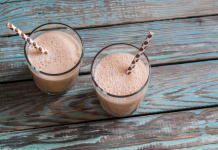
We know that while you are pressed for time, you try to stay on top of healthy eating. In this busy world it can be hard to know how to do both. What could be simpler than drinking your fruits and vegetables for a meal? In this article, you will learn how to make a delicious shake in just minutes that will not pack on unintentional pounds.
There is frequent talk in the nutrition world about juicing and blending. Did you know that juicing and blending is not the same thing? Juicing removes the pulp, for a drinkable way to get vitamins. However what you may not realize is juicing concentrates the fruit’s sugar and excludes one of the most beneficial parts of the plant, the fiber. Fiber maintains digestive function, lowers cholesterol and aids in fullness which is key for anyone trying to lose weight. Blending on the other hand, allows you to include the whole fruit or vegetable into the drink and you can add in protein and healthy fat to make it satisfying and balanced.
Not all blended drinks are created equal. Be aware of what to watch out for when buying shakes and smoothies in stores, coffee shops, restaurants and smoothie bars. They can contain absurd amounts of sugar and calories, yet are labeled and marketed as healthy options.
When purchasing a bottled smoothie drink, look for the serving size first. Usually a bottle contains 2 or more servings. Every 4 grams of sugar per serving is equal to 1 teaspoon of sugar. In many popular 16-ounce smoothies and juices, it is common to see 40 to 60 grams of sugar!
Also be mindful of portions, many stores are now selling 16, 20 and 32-ounce drinks which provide over 700 calories and 95 grams of sugar that can be slugged back in a matter of minutes.
Watch out for key terms on labels that are there specifically to create a healthy look and feel. Just because a drink claims to contain a “super-antioxidant” blend does not mean that it is good for you. In fact, that high amount of sugar in one meal will send your blood sugar and insulin levels skyrocketing and actually can make you hungry 30 minutes later.
At a smoothie bar you can request substitutions like water for juice, or milk and ice instead of frozen yogurt. The protein and fiber boosters can also be pretty low. Check to see that the boosters will be adding at least 7 grams of protein and 3 grams of fiber for a true boost. Always ask to see the nutrition facts before ordering.
Blending, as opposed to juicing, can be an effective way to get in whole fruits and vegetables on your way out the door or after a workout. The ideal way to do this is to blend your own shakes at home. You can control the ingredients and know exactly what you are drinking. Here are ingredients to include in a nutritious, balanced meal or snack that is also quick and convenient:
Include:
Protein – 1 cup plain Greek yogurt, low-fat or skim milk, organic soy milk or 1-2 scoops protein powder
Carbohydrate: 1 cup fresh or frozen fruit and 1/2 a medium banana or 1/4 cup dry rolled oats
Fiber: In addition to the fiber in the fruit, add 2 Tbsp unsweetened cocoa powder (2 g fiber per Tbsp and only 10 calories!) or ground flaxseed.
Healthy fat: 2 Tbsp almond meal, flaxseed meal, 1-2 Tbsp peanut butter, almond butter, 2 tbsp chopped walnuts or 1/2 cup coconut milk
Vitamin/Antioxidant boost: 1-2 cups kale or spinach leaves, 2 Tbsp unsweetened cocoa powder, or 1/4 cup unsweetened cherry, blueberry or cranberry juice
Tip: For easy blending start with the liquid first, then add the protein, carbohydrate, fat and greens.
Sample recipes:
Chocolate-Peanut Butter Lite Shake
1 cup milk
1/2 frozen medium banana
1 Tbsp natural almond or peanut butter
1 cup baby spinach
2 Tbsp unsweetened cocoa powder
Berry Flax Breakfast Shake
1/4 cup water
1 cup plain nonfat yogurt (Greek-style provides more protein than traditional)
1/4 cup blueberry juice
1/2 cup frozen blueberries
1/2 cup frozen mango
1 cup baby spinach
1/4 cup dry rolled oats
2 Tbsp ground flax
By Sumner Brooks, Registered Dietician for RockIt Body Pilates










